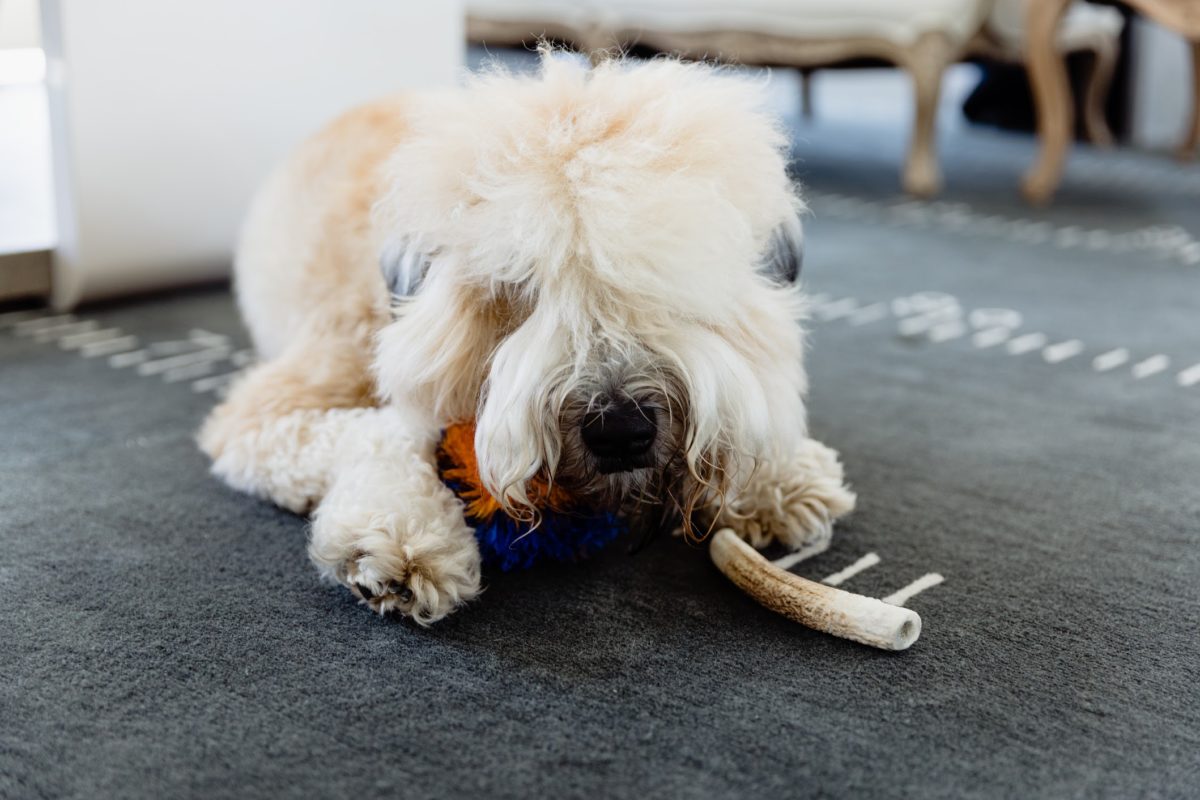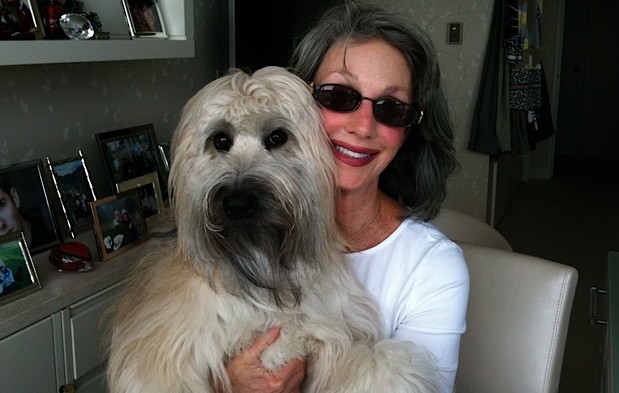
America Good
The love and devotion my Ultimate Concierge and I have received from our dogs, our beautiful Orchid, and our deliciously happy America, have outweighed any troubles either pooch has gotten themselves into. Such examples include eating shoes, awakening me at 3:00 am to take a necessary walk, or running off with my clothes. Our Soft-Coated Wheaten Terriers have brought a sense of serenity and joy into our otherwise hectic, busy lives.
Animals, especially dogs, have evolved to recognize and respond to human emotions, which plays a crucial role in animal social cognition and adaptive behavior. As pets, dogs form a deep emotional bond with their owners, perceiving and reacting to our feelings and body language.
The benefits and surprises of having a dog as a family member make all dog lovers’ hearts sing. They bring joy to us and we make them happy, too. It’s a mutually beneficial relationship! Scientific studies on the canine brain, using MRI scans, have shown which areas are involved in feelings like love and excitement, providing insight into the neurological basis of canine emotions. Canis familiaris, our domestic dogs, have a unique capacity for emotion perception and play a special role in the dog–human relationship. Don’t take my word for it, get it straight from the pooch’s mouth. Here’s a letter America wrote to my readers, you’ll adore it!
Our Pet’s Emotional Capacities
There is no benefit for dog owners like Shelly and myself to expect what cannot be expected from our pooches. For example, our dog will never be able to feel guilt. You may think your pooch experiences guilt when you arrive home to find his droppings on the floor while he slinks around. He is slinking because he has learned that bad things will happen to him so what you are really seeing is his fear of punishment. Most studies conducted by researchers on dogs’ emotional recognition have focused on family pets and populations in certain regions, which may limit our understanding of the full scope of dog behaviour and emotional responses.
We all know that our dogs experience basic emotions including love, fear, shyness, distress, arousal, contentment, joy, and anger. But did you know that dogs do not experience more complex emotions such as guilt, contempt, pride, and shame? The emotional range of dogs is similar to that of a two-year-old child, meaning dogs feel a variety of emotions but not the more complex ones.
This happens because a dog’s emotional development stops at approximately two and a half years old. Science has progressed a long way and we know that dogs possess all of the same brain structures that produce emotions in humans because they have the same hormones and undergo the same emotional changes that we do under emotional states.
They have oxytocin, which brings forth love and affection, explains Stanley Coren. Oxytocin levels increase during positive social interactions between dogs and humans, strengthening their bond. However, Coren notes that the range of human and dog emotions differs because our pooches’ minds are equivalent to roughly a two-year-old grandchild. A child does not fully understand the emotions of guilt, shame, and pride until they are three years of age and they don’t typically understand contempt until age four. Dogs, like human beings, are able to perceive and respond to human emotion and human emotions, often reacting to our feelings through their body language and behaviour. While dogs feel emotions such as sadness and other negative emotions, they do not experience more complex feelings like spite.
Dogs and humans process emotional stimuli in a similar way, relying on social cognition and interpreting social cues as part of dog behaviour. Observing a dog’s response to a specific event can reveal their natural interest and dogs emotional responses, which are often visible in their behaviour and body language.
So, my darling, only expect from your divine doggies what they are able to understand and feel.
Deciphering Dog Body Language
Understanding dog body language is truly the key to unlocking the emotional lives of our beloved canine companions. As dog owners, we often wish our dogs could speak to us, but in reality, they are communicating all the time—just not with words. Instead, dogs express their feelings through a rich tapestry of body language, from the tips of their wagging tails to the subtle shifts in their facial expressions and posture.
A happy dog is easy to spot: you’ll notice a relaxed body, a gently wagging tail, and a soft, open mouth that almost looks like a smile. Their eyes will be bright, and they’ll often make friendly eye contact, inviting you to share in their joy. On the other hand, when a dog is feeling fearful or anxious, their body language changes dramatically. You might see flattened ears, a tucked tail, and a tense, closed mouth. Some dogs will avoid eye contact altogether, signaling their discomfort or distress.
Recognizing these emotional cues is essential for dog owners who want to respond appropriately to their dog’s needs. For example, if your dog’s ears are pinned back and their body is low to the ground, they may be feeling scared or threatened. By understanding these signals, you can help your dog feel safe and supported, whether that means giving them space or offering gentle reassurance.
Current research in animal cognition has revealed just how attuned dogs are to both their own emotions and the emotions of the humans around them. Dogs are masters of emotional contagion—they can sense when we’re happy, sad, or stressed, and often mirror our emotional state. This remarkable ability is thought to be linked to oxytocin, the “love hormone,” which helps strengthen the bond between dogs and their owners.
But dog body language isn’t just about tails and ears. Pay attention to your dog’s mouth, too—a relaxed, open mouth usually means your dog is content, while a tightly closed mouth can signal tension or unease. The position of their front legs, the way they hold their head, and even the way they move around the environment all offer clues to their emotional state.
By learning to read these subtle cues, dog owners can deepen their understanding of their dog’s emotional world. It’s not just about recognizing emotion—it’s about responding with empathy and care. When we tune in to our dogs’ body language, we show them that we value their feelings and are committed to their well-being.
Ultimately, deciphering dog body language is about more than just avoiding misunderstandings—it’s about honoring the sentience and emotional experience of our dogs. As research continues to shed light on the complexities of dog emotions and animal cognition, we are reminded that our dogs are not just pets, but family members with rich inner lives. By responding to their emotional needs with compassion and understanding, we create a happier, more harmonious home for everyone—two-legged and four-legged alike.
A True Story of a Dog Owner’s Love
It was a rainy weekend and my daughters were bored. They came up with the idea that we should get another dog. I don’t recall how we found our new furry friend, although I do remember a litter of pups caged in a dark basement. Obviously, today I would have never gone down into a stranger’s basement.
My youngest daughter chose the runt of the litter and my other daughter and I agreed because we felt sorry for the little tyke. We took him home and he never quite adjusted to our family. He displayed behaviors such as hiding, avoiding interaction, and being hesitant to explore, as he tried to adjust to his new environment. Off of our kitchen was a dark powder room and the dog made it his home. Obviously, it reminded him of his ragged home in the dark basement. At that time, we were a busy family and the poor little fellow did not receive the extra care he needed until he met his new owners. As a dog owner, I realized that an owner’s actions and attention can greatly impact a dog’s emotional well-being.
One day, three years later, I made the decision to find the dog a loving home. I placed a clever ad in the newspaper and had lots of lookers who I turned away. I was giving this pooch away and I was determined to find him the home of his dreams.
Our Pooch’s New Home
One day, an older couple stopped by our home. Their children were grown. They were a gentle, warm couple who had lost their dog.
I told them the story of our dog. I told the couple they could return him. And, I asked them to keep me updated on his progress and their happiness. They kept their promise and gave our little 3-year-old pooch a life set for a king.
It was tender love and care that turned our pooch from a shy, distressed dog into the king of the mountain! His improved emotional state was clearly reflected in his dog communication, as seen in his relaxed body language and positive interactions with his new owners.
King of the Mountain Indeed
After approximately two weeks, the woman phoned me and told me the dog was sleeping outside their bedroom door. Our phone rang a few weeks later and I heard a joyful voice over the line tell me the pooch was sleeping next to her side of the bed. Not long after, she rang again with laughter and joy because the dog was sleeping in bed with this wonderful couple.
They understood the mentality of a dog. With their tenderness and warmth, they wrapped their arms around him lovingly and he responded by returning his love.
Over time, she would call me to tell me about their experiences with the dog. They took him out for dinner to a restaurant every Friday night, to the Kentucky Derby every year, and on various trips across the country. He had outfits for the Derby and steak night every Friday night. Because dogs cannot feel embarrassed, he went along with their program!
And as The Beatles say, all you need is love…

Orchid Good
So Much Love For Our Pooches
Dogs give us signals of their love. Wet kisses on our faces are outpourings of their affection and enjoyment. When they rest their paw on our body, it’s a signal of affection and many other things–all positive.
Dogs also use play to express affection and bond with their family members. Playful behaviors like wagging their tails, bowing, or running around are clear signs they want to engage and connect.
A dog’s favorite member of the family is usually the person who matches their energy level and personality. Dogs sleep with us because dogs travel in packs and they are telling you that you are a member of their pack.
If you’d like to treat your pooch like the king or queen he or she is, please tell me in the comments at the bottom of this page. I would also love to see pictures of your dogs, as well! I am smiling.

If you enjoyed this story, please subscribe.
+ show Comments
- Hide Comments
add a comment